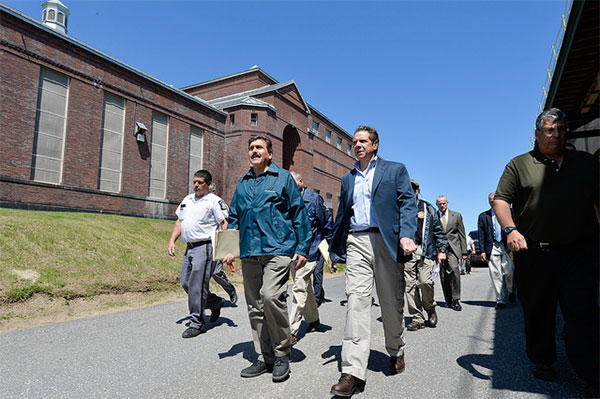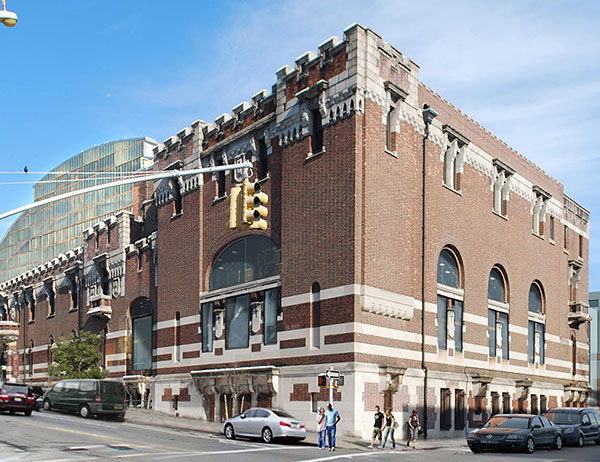On New York’s Amazon Wishlist? More Homegrown College Graduates

(via amazon.com)
Bids are due today for Amazon’s new headquarters and it seems cities across North America have joined the fray. The suitors are lining up with billion-dollar bouquets, and with good reason. What mayor could resist the promise of 50,000 well-paying jobs and all the economic energy that comes with the headquarters—a massive boost to the tax base, new cafes and food trucks, spin-off companies, and a legion of happy vendors? New York City alone has nearly two dozen neighborhoods vying for Bezos’ bounty.
Pundits have frequently written off the five boroughs as Amazon’s second home because of the exorbitant cost of living. Some are pointing to the subway meltdown. Yet an even greater obstacle may be the city’s underprepared workforce.
While New York has always been a beacon for titans of industry, striving immigrants, and the creative cognoscenti, for too long, the city has failed to develop enough local talent into the kind of smart, savvy employment base a modern company like Amazon demands. Just 36 percent of New York City residents have a bachelor’s degree or higher, according to the latest Census data, compared to 45 percent in Denver, 46 percent in Austin, and 55 percent in Washington, D.C. In Amazon’s current home base of Seattle, it is a whopping 59 percent.
New York’s ability to lure the world’s fourth largest corporation, or even its 40th or 400th, will hinge on whether its workforce is primed and ready. By that measure, the city has a long way to go.
More than 3.3 million city residents over age 25 lack an associate’s degree or higher level of college attainment. Residents with a bachelor’s degree or higher are largely concentrated in Manhattan, where the attainment rate stands at 62 percent, followed by just over 30 percent in Brooklyn, Queens, and Staten Island. In the Bronx, it is a distressing 18 percent.
Amazon should still see boundless potential on the Hudson. New York boasts a booming and entrepreneurial tech sector with more than 115,000 jobs today, an unparalleled smorgasbord of arts and culture, and the brand new Cornell Tech campus, alongside other world-renowned educational institutions.
But if New York succeeds in attracting Amazon, or any large company for that matter, whether GE, Aetna, or Tesla, it will be in spite of the city’s education and training systems, not because of them. New York can do so much more to ensure that its residents can access the opportunities that an Amazon would bring, while offering employers a much larger pool of homegrown talent.
Yes, New York is full of tech talent today. This is true, in part, because the city has become increasingly successful at attracting engineering and computer science graduates from Stanford, Carnegie Mellon, and other top universities around the world. But in an economy where technically skilled workers are prized—not just on Silicon Alley but in nearly every large and mid-sized company—demand is through the roof. New York needs a much bigger pipeline, not just for Amazon, but for blue chip companies and local start-ups alike.
Even if the vast majority of Amazon’s 50,000 new hires were imported from other places, New York would still be better off with them here than in Denver or Chicago or Atlanta. But no company—and certainly not a company with so many hiring needs—is going to make locational decisions that are completely dependent on bringing in outside talent. It is simply not realistic, or sustainable. Meanwhile, if half those workers or more were born, raised, and educated in New York, the benefits would be far broader—allaying the fears of those who see Amazon as more of an economic development trophy than an opportunity generator.
Such an achievement today would be almost impossible.
While New York City has done an increasingly impressive job of getting students through high school, it continues to struggle with college success, leaving students without the credentials an employer like Amazon demands. Today, fewer than half of all four-year college students at the City University of New York (CUNY) graduate with a degree in six years. Just 22 percent of CUNY’s community college students earn a degree in three years.
CUNY’s highly successful ASAP initiative, which provides supports to full-time community college students, and the CUNY Start program, which provides intensive preparation for students with remedial needs, are important steps in the right direction. But New York has a long way to go to achieve true college success for all.
Beyond the classroom, the city’s workforce development system still functions too much like a cumbersome placement agency. The de Blasio administration has laid out an impressive new vision with its Career Pathways initiative, aimed at developing career trajectories through skills building and education. But after more than three years, there is too little to show for it. The city needs to double down on proposed investments in bridge programs, career exploration, and on-the-job training, while strengthening and expanding partnerships with nonprofit providers, employers, and the public education system.
There’s no doubt that New York City is a formidable competitor in the quest for Amazon’s HQ2. No other city offers so expansive a world of culture and commerce in a single place, a paragon of urbanism and urbanity animated by an astonishingly diverse population. But if Amazon heads elsewhere, policymakers should not just blame cost and congestion. They should look to the serious shortcomings in the city’s human capital development system, which remains far from meeting its full potential.
***
Matt A.V. Chaban is the policy director and Fisher Fellow at the Center for an Urban Future. On Twitter @MC_NYC and @nycfuture.
***
Have an op-ed idea or submission for Gotham Gazette? Email This email address is being protected from spambots. You need JavaScript enabled to view it.
As We Close Rikers, Setting Our Sights on Essential State-Level Reforms

Gov. Cuomo at an update prison (Governor's Office)
Anyone following New York City politics knows about JustLeadershipUSA’s mission to close the jails at Rikers Island. In less than a year, the #CLOSErikers campaign successfully pressured Mayor Bill de Blasio to commit to shuttering the jail complex. It is no longer a question of if Rikers will close, but when. But the campaign has always known that closing Rikers would require reforms at the state level as well. An overhaul of our statewide bail, speedy trial, and discovery statutes is necessary to reduce the population at Rikers so that it can finally and expeditiously close its doors.
Even if Rikers were closed tomorrow, these reforms would still be necessary. While New York City has successfully reduced its jail population over the past few years, county jail populations across the state are growing. Today, 63% of people held in jail in New York State are held in jails outside New York City. Of those 25,000 husbands, fathers, brothers, sisters, children, and loved ones who are sitting in jails across our state, 70% have not been convicted but remain unjustifiably caged while they await the outcome of their cases.
This reality is a consequence of punitive and discriminatory criminal justice policies that have decimated communities, primarily poor communities and communities of color, for decades.
To end this human rights crisis, we need bold action from Governor Andrew Cuomo and our state Legislature. That is why JustLeadershipUSA launched #FREEnewyork, a campaign focused on empowering those who have been most harmed by our jails and prisons to hold Governor Cuomo and our elected leaders in Albany accountable and unapologetically demand real solutions to these self-inflicted problems.
Governor Cuomo said that Rikers should be closed in three years. Now he must deliver around the state he leads. He and his colleagues in Albany have both the power and the responsibility to drive us toward that Rikers goal while also addressing the failings of our statewide criminal justice system.
They can start with overhauling our broken bail system. We need reform that eliminates money bail, protects the presumption of innocence and the right to freedom, limits when and how any pretrial conditions are instituted, and prohibits biased risk assessment tools. Bail reform must focus on ending the devastating repercussions that even initial involvement with the criminal justice system can have on people, especially on low-income families who too often must choose between paying bills or paying for their loved one’s freedom. People who can afford bail achieve better outcomes in their cases, and everyone deserves access to these outcomes.
Albany must also enact comprehensive statewide speedy trial and discovery reform. Today, no other state in the country comes close to matching the appalling unfairness of New York’s readiness rule approach to ‘protecting’ one’s right to a fair and expedient process.
We need a true speedy trial law that sets concrete limits on when a defendant must actually be brought to trial. As it stands now, prosecutors can cause unforeseeable and unending delays in the trial process without significant repercussions. Combined with the current state of our bail laws, this leads to human beings trapped in cages while they await their hearing before a judge or jury.
What is already a bad situation is only made worse by New York’s current discovery laws, which are widely regarded as some of the most regressive in the country. We need a new discovery law that requires open, early, automatic, and mandatory discovery, guaranteeing defendants and their lawyers access to vital information about their cases. Without this, defendants and their attorneys have little to no access to information about the charges they face.
These reforms are vital for New Yorkers most affected by mass incarceration, and countless studies have shown that criminal justice reforms like these increase public safety, improve relations between communities and law enforcement, and create better outcomes for victims and taxpayers. Yet, while each of these reforms and each of their respective components are important, none are sufficient on their own if we truly want to end the plague of mass incarceration that grips New York State. Comprehensive, connected reforms are necessary for the real, lasting, and positive change in our criminal justice system that New Yorkers deserve.
Without this action at the state level, New York will continue to commit human rights abuses on a daily basis. The atrocities of our criminal justice system will linger, and New Yorkers will suffer unimaginable harm as a result. To fight for reform, close Rikers, and decarcerate county jails throughout New York State, directly impacted individuals and communities across the state must raise their voice, and, together, bring a simple message to Governor Cuomo and our legislators in Albany: we are watching you, we demand real and bold reform, and the time to act is now.
***
Glenn E. Martin is founder and President of JustLeadershipUSA. On Twitter @GlennEMartin and @JustLeadersUSA.
***
Have an op-ed idea or submission for Gotham Gazette? Email This email address is being protected from spambots. You need JavaScript enabled to view it.
Don’t Forget: Cumbo Won with Promise of 100% Affordability at Armory

Bedford Union Armory rendering
For months, thousands of Crown Heights residents have petitioned, testified, marched, and protested against a proposed redevelopment at the Bedford Union Armory, where the plan backed by the de Blasio administration would take a massive parcel of public land and give it to a private developer to build high-end housing and a recreation facility.
The local City Council member, Laurie Cumbo, recently won her Democratic primary for reelection after opposing the deal, promising that she would insist on no luxury condominiums, while her backers promised she’d push for 100% affordable housing at the site. But Cumbo is now moving the goalposts in a dangerous direction.
Crown Heights is one of New York City’s most rapidly gentrifying neighborhoods. In 2015, over 20,000 families faced eviction in the three zip codes surrounding the armory, many of whom lived in the community long before it became a “place to be” for those moving into the area. Nearly 30% of shelter entrants in the city are from Brooklyn and if this project proceeds as currently designed, even more longtime community members (many whom are people of color and of West Indian descent), will be displaced from their homes and have to move to a shelter that probably won’t be across the street like the mayor’s plan suggests.
From the beginning, the community’s demand has been simple to understand. Kill this deal. Go back to the drawing board to create the truly affordable housing that’s desperately needed.
We need a community land trust with local control over the land, and real low-income housing. The only housing to be built should be to protect the victims of gentrification -- displaced homeless families and those at risk of displacement -- not to facilitate more of the same problem. It appeared that Council Member Cumbo had finally listened to her constituents when she opposed the plan currently on the table.
But in a recent New York Times article on the mayor’s housing plan, Cumbo declared that “the community put the line in the sand: no luxury condominiums.”
This “line in the sand” signifies a bait-and-switch. In fact, it’s simply where Cumbo has moved the goalposts after winning a competitive election, and the Council member should know that the community sees what’s happening.
Redevelopment of the Bedford Armory was the central issue in the recent primary. During the campaign, Cumbo supporters spent $135,846.64 on more than 10 mailers and robocalls in an effort to convince Crown Heights voters to support her. These mailers were clear on Cumbo’s position: shut the deal down without 100% affordability at the armory site.
Cumbo won promising a much better deal, and now she just wants to scrap the condos.
Let’s be crystal clear: a project that moves forward with any luxury housing – rentals or condos – is still not a project for us. A community land trust with real low-income housing would be a practical solution that could contribute to solving the homelessness crisis in Brooklyn and in New York City overall, especially since this is public land. But a housing plan that moves forward with only 18 units affordable to the average resident of Crown Heights is not just unacceptable, it’s an insult.
If Cumbo doesn’t kill the deal, she will have allowed her supporters to openly lie to the electorate during her primary campaign.
And to add injury to insult, Mayor de Blasio is busy explaining away his failing housing policies by blaming the constraints of the free market and capitalism. But those restraints don’t exist on public land like they do on private land. The Bedford Union Armory is a wholly socialist enterprise — like the mayor claims he would want.
What is the mayor doing with these “socialist” powers? Making a conscious decision to privatize land and “harness” gentrification, rather than fight it.
Public land is a vanishing resource in New York City. At a time when we continue to struggle with a record homelessness crisis and massive displacement of low- and moderate-income people, many people of color, it should also be priceless.
This is particularly egregious when more and more human beings are being warehoused in shelters, just like the one recently opened a few blocks from the armory, with a number of residents not being from the area, as the mayor claims is his goal. Despite what the mayor and Council Member Cumbo say in their press clippings and campaign advertisements, their policies show exactly where their priorities lie: luxury housing to make developers rich and house people who have no fear of being homeless, and shelters for far too many others.
It really is still a tale of two cities out here.
But Cumbo still has a chance to live up to the promises she made during her primary campaign, cutting out greedy developers and giving us a community land trust with 100% affordable housing on this precious public land.
Or she can get rid of a few luxury condos and tell us that this is some kind of victory, despite the fact that half the units would still be luxury rentals and a pitiful 5 percent would be affordable to the average Crown Heights resident, the same residents who have supported her.
We look forward to working with Council Member Cumbo on developing the community land trust this neighborhood needs, especially on public land, as we know she wants to do the right thing. There’s still a chance.
But make no mistake, we won’t let the wool be pulled over our eyes.
***
Monique “Mo” George is the Executive Director of Picture the Homeless. On Twitter @pthny.
***
Have an op-ed idea or submission for Gotham Gazette? Email This email address is being protected from spambots. You need JavaScript enabled to view it.




